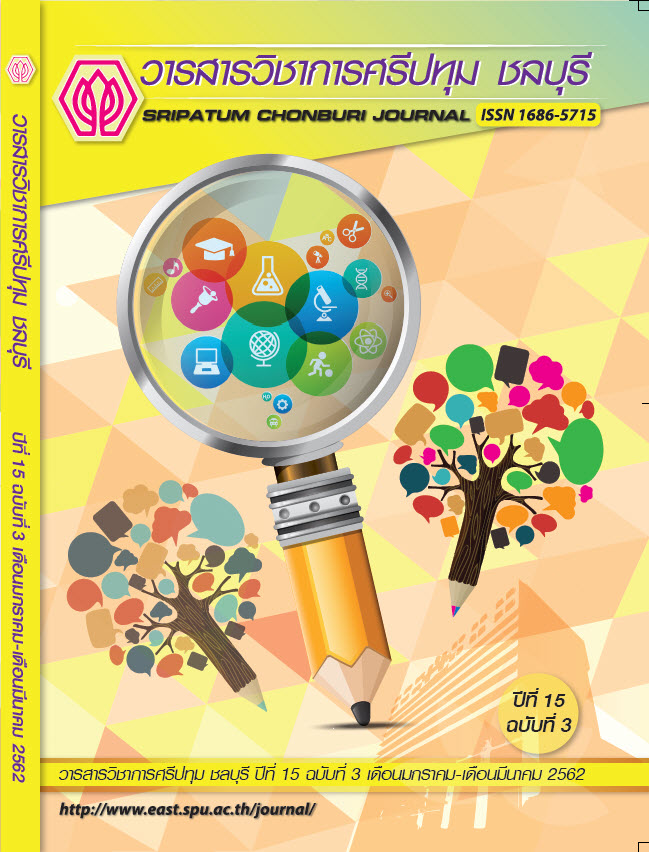THE GUIDELINE FOR MODERN ORGANIZATION MANAGEMENT APPROACH BASED ON EMPOWERMENT AND PARTICIPATION OF MEMBERS IN THE ORGANIZATION
Keywords:
management, modern government organizations, decentralization, participation, organization’s membersAbstract
This article aims to study the modern business management approach by using the principle of empowerment and participation of members in the organization based on literature review. The author summarized modern enterprise business management approach using the principle of empowerment and participation of members in the organization as the organization must aim for self-empowerment and taking ownership of your life including ways to work independently and freedom to make decisions and take actions– promoting social inclusion and equality-creating a meaningful workplace-establishing networking, and corporate culture for collaborative learning in order to move the organization forward with intellectual acuity and positive ideas.
References
5 กันยายน].
นิรันดร์ จงวุฒิเวศน์. (2550). แนวคิดแนวทางการพัฒนาชุมชน. กรุงเทพฯ: กรมการพัฒนาชุมชน กระทรวงมหาดไทย.
มธุรดา ศรีรัตน์. (2554). การบริหารแบบมีส่วนร่วม (ออนไลน์). เข้าถึงได้จาก: www.http://gotoknow.org/blog/mathu/33443 [2561, 5 กันยายน].
Bennett, Tony. (2010). Employee voice initiatives in the public sector: Views from the workplace.
International Journal of Public Sector Management, 22(5), pp. 444-455.
Bennis, Warren G., & Goldsmith, Joan. (1994). Empowerment in learning to lead. Boston, MA: Addison-Wesley.
Charles, Baden-Fuller, & Haefliger, Stefan. (2013). Business models and technological innovation. Long Range Planning, 46(6), pp. 419-426.
Chesbrough, Henry. (2010). Business model innovation: opportunities and barriers. Long Range
Planning, 43(2-3), pp. 354-363.
Collins, Jim. (2001). Good to great: Why some companies make the leap and others don’t. New York,
NY: Harper Business. David, Keith, & Newstrom, John W. (1989). Organizational behavior. New York, NY: McGraw-Hill.
Drueker, Peter Ferdinand. (2016). Importance of management to a modern business (Online).
Available: http://www.yourarticlelibrary.com/essay/importance-of- management-to-a modern-
business/27885/Wenda [2017, September 5].
Eisenmann, Tomas, Parker, Geoffrey, & Alstyne, Marshall Van. (2001). Platform envelopment strategic.
Management Journal, 32(12), pp. 1270-1285.
Erickson, Tamara J., et al. (1990). Managing technology as a business strategy (Online). Available:
https://sloanreview.mit.edu/article/managing-technology-as-a-business-strategy/ [2017, September 5].
Hao, Shengbin, & Yu, Bo. (2009). Research on impact mechanism of technology strategy on technology innovation and organizational performance. Studies in Science of Science, 27(8), pp. 1263-1270.
Hersey, Paul, Blanchard, Kenneth H., & Johnson, Dewey E. (2001). Management of organization behavior: Leading human resources (8th ed). Englewood Cliffs, NJ: Prentice-Hall.
HPO Center. (2016). High performance organization (HPO) framework (Online). Available:
http://www.hpocenter.com/hpo-framework/ [2017, September 5].
Kanter, Rosabeth Moss. (1983). The change masters corporate entrepreneurs at work. London, UK:
Loutledge.
Kaplan, Robert S., & Norton, Ddavid P. (2001). The strategy-focused organization: How balanced scorecard companies thrive in the new business environment. Boston, MA: Harvard Business
School Press.
Koontz, Harold, O'Donnell, Cyril, & Weihrich, Heinz. (1986). Essentials of management (4th ed.).
New York, NY: McGraw-Hill.
Laschinger, Heather K., Finegan, Joan, & Shamine, Judith. (2001). The impact of workplace empowerment, organizational trust on staff nurses’ work satisfaction and organizational commitment. Journal of Health Care Management Review, 26(3), pp. 1-21.
Masanell, Ramon Casadesus, & Zhu, Feng. (2010). Strategies to fight Ad-sponsored rivals. Management Science, 56(9), pp. 1484-1499.
Nyhan, Ronald C. (2000). Changing the paradigm: Trust and role in public sector organization. American Review of Public Administrations, 30(1), pp. 1-24.
Parsons, Ruth J. (1988). Empowerment for role alternatives for low income minority girls: A group work approach. Social work with groups. A Journal of community and clinical practice, 11(4), pp. 27-45.
Pilgrim, Anthony. (2012). Empowerment: What does it mean to you? (Online). Available:
https://www.slideshare.net/undesa/empowerment-what-does-it-mean-to-you-24592326 [2017, September 5].
Saeidi pour, Bahamn. (2014). Analysis of the impact of information technology, and perceived organizational justice on employee empowerment (case study: Payame Noor University of Kermanshah province). Mediterranean Journal of Social Sciences, 5(20), pp. 3037-3047.
Putti, Joseph M. (1987). Work values and organizational commitment: A study in the Asian context.
Human Relations, 4(2), pp. 275-288.
Rappaport, Julian. (1987). Terms of empowerment/exemplars of prevention: Toward a theory for community psychology. American Journal of Community Psychology, 15(2), pp. 121-148.
Schadt, Kenneth. (2012). Empowerment: What does it mean to you? (Online). Available:
https://www.slideshare.net/undesa/empowerment-what-does-it-mean-to-you-24592326 [2017, September 5].
Thomas, Kenneth W., & Velthouse, Betty A. (1990). Cognition elements of empowerment: An interpretive model of intrinsic task motivation. Academy of Management Review, 15(4), pp. 666-681.
Downloads
Published
Issue
Section
License
บทความทุกบทความเป็นลิขสิทธิ์ของวารสารวิชาการศรีปทุม ชลบุรี



